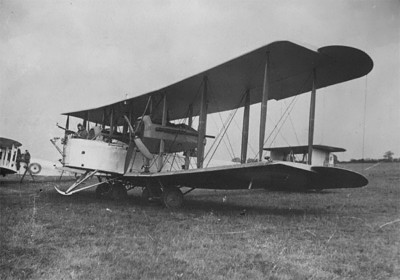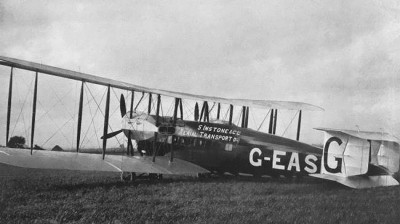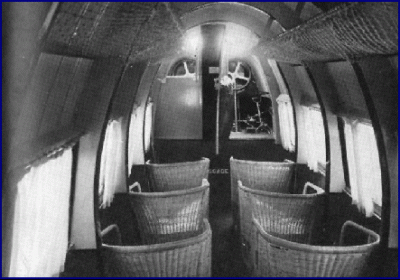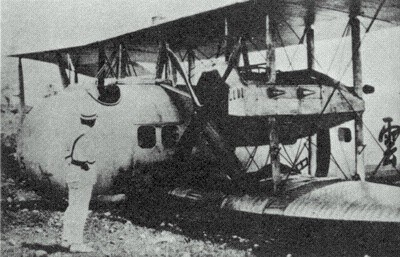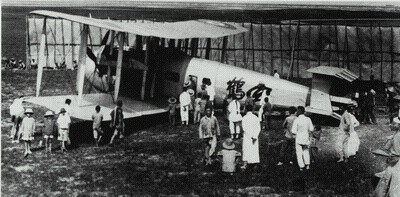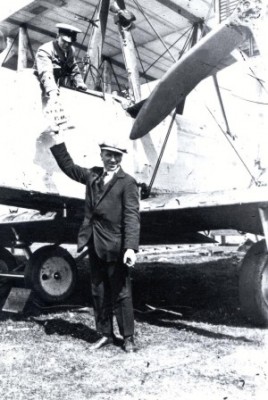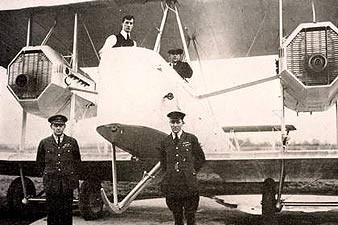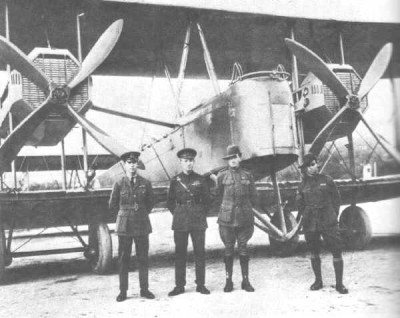Vickers Vimy
In 1917, the British Air Authority felt the need to make some use of the stock of surplus 147 kW Hispano Suiza HS 8Ba French engines it had in its warehouses. Vickers was therefore tasked with building a bomber equipped with these engines and capable of similar performance to the competing Handley-Page 0/400. Within four months, under the direction of chief designer Reginald K. Pierson built the prototype, which first flew on 30 November 1917. Experiments with the installation of other engines began immediately - on the first prototype the Hispana was replaced by 191 kW Salmson radial engines (these did not prove very successful), the second prototype received Sunbeams Maori of the same power (they failed badly, this prototype was destroyed in flight due to engine failure), the third a 221 kW FIAT A-12bis, and the fourth two Rolls-Royce Eagle VIII of 265 kW, which eventually proved most suitable for series production. The resulting triple-truss twin-engined biplane was designated F.B. 27 (the letters F.B. stood for Fighting Biplane) and had twin tail surfaces and a fixed aft undercarriage with an auxiliary ski under the nose. The fuselage was square in section with a truss and canvas covering, the nose with a steel tube frame, and the stern with wooden struts. The range of the prototype was 3,060 km, the top speed was between 157 and 177 km/h and the range was measured at 3,650 m. It took 18 minutes to climb to an altitude of 1820 m.
Series production began in March 1918 with 150 units being built at the Crayford plant, while an order for 200 units, which followed the next day, was to be filled by the Weybridge plant. Plans for their use varied, ranging from tactical to strategic to anti-submarine use, which eventually gained the most support. In October 1918, one more Vimy, as the type was officially named (after the battle of the same name), was sent to the Independent Air Force at Nancy to prepare for bombing German cities; there were also plans for "turn-around" deployments - the plan was to take off from England or France for raids on Berlin and the surrounding area, then proceed to the new Allied capital, Prague, and return with a new load of bombs to finish the job... In total, over 1,000 machines were required (equipped with several different engines, including the American Liberty twelve-cylinder 294 kW, but the only prototype with these engines burned before completion). In the meantime, however, the war was over and plans had to be scaled back. Only 13 machines were built before the Armistice, of which only three were handed over to the RAF. Orders were meanwhile limited to 221 machines. All production machines were delivered in the F design. B. 27A or Vimy Mk.II (sometimes, however, referred to as Mk.IV) with Rolls-Royce Eagle VIII engines.
By July 1919, the Vimy was already on full duty in the RAF, its first duty station being 58 Squadron in Egypt. It thus became the main British heavy bomber for most of the 1920s. In the Middle East from 1925, the Vimy was replaced by its "descendant" Vickers Virginia in Northern Ireland until 1929. After withdrawal from the front line, most aircraft were given Bristol Jupiter or Armstrong Siddeley Jaguar radial engines. In addition to its original role as a long-range bomber, the Vimy was then also used to train bomber crews, transport and parachute aircraft - the paratroopers were carried out on the wings while holding on to the struts. After the war, the Vimy was also used to test, for example, 37mm COW (Coventry Ordonnance Works) gun armament, automatic landing, etc.
In 1919 a civilian version of the aircraft was also produced, Vimy Commercial, which with some modifications was supplied to the RAF as a transport under the name Vickers Vernon. The Vimy Commercial was distinguished by its new massive shell nose, which provided sufficient space to comfortably carry ten passengers in an enclosed cabin (the crew had their space uncovered, of course), but at the same time its increased drag significantly reduced range. The stern was exactly the same as in the classic Vimy, only it was "glued" to the new profile by shaped plates. The prototype, originally called the Vimy Monocoq, was flown on 13 April 1919 with the provisional registration K-107. A derivative variant Vimy Ambulance was also built for the RAF, which had a cabin in the same bulbous fuselage modified for six recumbent or eight seated wounded and two attendants. There was also a new door in the bow through which stretchers were loaded.
Forty of the forty-three production Vimy Commercial machines were ordered by China. They were delivered in 1920-1921 and seven were used in government service on mail lines. The others were left in warehouses for a long time, but some of them were later used after all - as bombers in the civil war that broke out in 1924. Although the circumstances of their deployment would certainly be interesting, unfortunately there is not much information on them.
European airlines did not show much interest in the type, as other machines with similar and often better characteristics soon appeared. At least one was purchased by the French Grands Express Aériens and one by Instone Airline. The aircraft, which was then acquired by Imperial Airways, became perhaps the most famous - it flew between England and France under the official name City of London, but was better known by the nickname "Old Go-easy" after its G-EASI matriculation. In 1922, one machine was purchased by the Soviet Air Force, which eventually handed it over to Dobroljot two years later.
On 14 June 1919, Arthur Whitten-Brown and John Alcock flew the heavily modified Vimy across the Atlantic for the first time non-stop, a total of 3,032 km from St. They flew from St. John's, Newfoundland, to Clifden, Northern Ireland, in 16 hours and 27 minutes, winning the £10,000 prize that Lord Nortcliffe had already put up in 1913 for flying from America to the British Isles. The flight did not end well - the plane got stuck in a swamp and was destroyed while attempting an early landing, but the crew were unharmed. In the same year, the Australian government announced a reward of 10,000 Australian pounds for aviators who flew from Britain to Australia in 30 days later in 1919. The Australian brothers Ross and Keith Macpherson Smith responded to the challenge and flew the 17,808 km distance from Britain to Australia in 135 hours and 55 minutes of flight time between November and December 1919 ...
Another attempt to set a record was worse. In early 1920, the London Times newspaper offered a traditional £10,000 reward to the first person to fly across Africa. A prototype Vimy Commercial (now renamed G-EAAV) was sent on the route, piloted by Captains S. Cockerell and F. C. Broome and also on board was Dr Chalmers Mitchell, Secretary of the Zoological Society. The aircraft successfully took off from London on 24 January 1920 and made most of the journey, but eventually crashed in the mountains near Tabora in what was then Tanganyika - it could not maintain lift during the flight in the hot high mountain climate and crashed. A competing flight, undertaken in February of the same year by Pierre van Ryneveld and Christopher Quintin-Brand at the instigation of the South African government, which of course had a vested interest in making this the first flight by South Africans, had a similar outcome. They flew their Vimy G-UABASilver Queen to Egypt, but a radiator failure caused serious damage to the aircraft during the emergency landing. The expedition therefore continued on another Vimy ("Silver Queen II"), loaned by the local RAF crew at the request of the South African government. However, this was also damaged, for similar reasons to its "commercial" competitor, at Bulawayo in Southern Rhodesia, so they were unable to continue with it. The flight was eventually completed 45 days later by Rynveld and Brand in a borrowed Airco DH.9, but by then the Times had been disqualified. A reward of £5,000 each was instead paid to them by the South African government, which complied with their request - the first to fly the entire distance across Africa were South Africans, albeit in three different machines.
A number of other large machines were built on the basis of the fairly successful, if non-warlike, Vimy, and in addition to the Virginia bomber mentioned above and the Vernon, there were also the colonial Victoria and Valentia aircraft and the Vanguard and Vulcan transport aircraft, which often remained in service well into the 1930s.
Units that used Vickers Vims:
7th RAF Squadron
9 Squadron RAF
24th RAF Squadron
45th RAF Squadron
58th RAF Squadron
70th RAF Squadron
99th RAF Squadron
100th RAF Squadron
216th RAF Squadron
500th RAF Squadron?
502nd RAF Squadron
Sources:
http://www.answers.com/topic/vickers-vimy
Vimy Commercial G-EASI "City of London" letecké společnosti S. Instone & Co. Zdroj: http://www.koolhoven.com/history/fk26/
Vimy Commercial G-EASI. Zdroj: www.geocities.co.jp
Interiér Vimy Commercial. Zdroj: www.imperial-airways.com
In 1917, the British Air Authority felt the need to make some use of the stock of surplus 147 kW Hispano Suiza HS 8Ba French engines it had in its warehouses. Vickers was therefore tasked with building a bomber equipped with these engines and capable of similar performance to the competing Handley-Page 0/400. Within four months, under the direction of chief designer Reginald K. Pierson built the prototype, which first flew on 30 November 1917. Experiments with the installation of other engines began immediately - on the first prototype the Hispana was replaced by 191 kW Salmson radial engines (these did not prove very successful), the second prototype received Sunbeams Maori of the same power (they failed badly, this prototype was destroyed in flight due to engine failure), the third a 221 kW FIAT A-12bis, and the fourth two Rolls-Royce Eagle VIII of 265 kW, which eventually proved most suitable for series production. The resulting triple-truss twin-engined biplane was designated F.B. 27 (the letters F.B. stood for Fighting Biplane) and had twin tail surfaces and a fixed aft undercarriage with an auxiliary ski under the nose. The fuselage was square in section with a truss and canvas covering, the nose with a steel tube frame, and the stern with wooden struts. The range of the prototype was 3,060 km, the top speed was between 157 and 177 km/h and the range was measured at 3,650 m. It took 18 minutes to climb to an altitude of 1820 m.
Series production began in March 1918 with 150 units being built at the Crayford plant, while an order for 200 units, which followed the next day, was to be filled by the Weybridge plant. Plans for their use varied, ranging from tactical to strategic to anti-submarine use, which eventually gained the most support. In October 1918, one more Vimy, as the type was officially named (after the battle of the same name), was sent to the Independent Air Force at Nancy to prepare for bombing German cities; there were also plans for "turn-around" deployments - the plan was to take off from England or France for raids on Berlin and the surrounding area, then proceed to the new Allied capital, Prague, and return with a new load of bombs to finish the job... In total, over 1,000 machines were required (equipped with several different engines, including the American Liberty twelve-cylinder 294 kW, but the only prototype with these engines burned before completion). In the meantime, however, the war was over and plans had to be scaled back. Only 13 machines were built before the Armistice, of which only three were handed over to the RAF. Orders were meanwhile limited to 221 machines. All production machines were delivered in the F design. B. 27A or Vimy Mk.II (sometimes, however, referred to as Mk.IV) with Rolls-Royce Eagle VIII engines.
By July 1919, the Vimy was already on full duty in the RAF, its first duty station being 58 Squadron in Egypt. It thus became the main British heavy bomber for most of the 1920s. In the Middle East from 1925, the Vimy was replaced by its "descendant" Vickers Virginia in Northern Ireland until 1929. After withdrawal from the front line, most aircraft were given Bristol Jupiter or Armstrong Siddeley Jaguar radial engines. In addition to its original role as a long-range bomber, the Vimy was then also used to train bomber crews, transport and parachute aircraft - the paratroopers were carried out on the wings while holding on to the struts. After the war, the Vimy was also used to test, for example, 37mm COW (Coventry Ordonnance Works) gun armament, automatic landing, etc.
In 1919 a civilian version of the aircraft was also produced, Vimy Commercial, which with some modifications was supplied to the RAF as a transport under the name Vickers Vernon. The Vimy Commercial was distinguished by its new massive shell nose, which provided sufficient space to comfortably carry ten passengers in an enclosed cabin (the crew had their space uncovered, of course), but at the same time its increased drag significantly reduced range. The stern was exactly the same as in the classic Vimy, only it was "glued" to the new profile by shaped plates. The prototype, originally called the Vimy Monocoq, was flown on 13 April 1919 with the provisional registration K-107. A derivative variant Vimy Ambulance was also built for the RAF, which had a cabin in the same bulbous fuselage modified for six recumbent or eight seated wounded and two attendants. There was also a new door in the bow through which stretchers were loaded.
Forty of the forty-three production Vimy Commercial machines were ordered by China. They were delivered in 1920-1921 and seven were used in government service on mail lines. The others were left in warehouses for a long time, but some of them were later used after all - as bombers in the civil war that broke out in 1924. Although the circumstances of their deployment would certainly be interesting, unfortunately there is not much information on them.
European airlines did not show much interest in the type, as other machines with similar and often better characteristics soon appeared. At least one was purchased by the French Grands Express Aériens and one by Instone Airline. The aircraft, which was then acquired by Imperial Airways, became perhaps the most famous - it flew between England and France under the official name City of London, but was better known by the nickname "Old Go-easy" after its G-EASI matriculation. In 1922, one machine was purchased by the Soviet Air Force, which eventually handed it over to Dobroljot two years later.
On 14 June 1919, Arthur Whitten-Brown and John Alcock flew the heavily modified Vimy across the Atlantic for the first time non-stop, a total of 3,032 km from St. They flew from St. John's, Newfoundland, to Clifden, Northern Ireland, in 16 hours and 27 minutes, winning the £10,000 prize that Lord Nortcliffe had already put up in 1913 for flying from America to the British Isles. The flight did not end well - the plane got stuck in a swamp and was destroyed while attempting an early landing, but the crew were unharmed. In the same year, the Australian government announced a reward of 10,000 Australian pounds for aviators who flew from Britain to Australia in 30 days later in 1919. The Australian brothers Ross and Keith Macpherson Smith responded to the challenge and flew the 17,808 km distance from Britain to Australia in 135 hours and 55 minutes of flight time between November and December 1919 ...
Another attempt to set a record was worse. In early 1920, the London Times newspaper offered a traditional £10,000 reward to the first person to fly across Africa. A prototype Vimy Commercial (now renamed G-EAAV) was sent on the route, piloted by Captains S. Cockerell and F. C. Broome and also on board was Dr Chalmers Mitchell, Secretary of the Zoological Society. The aircraft successfully took off from London on 24 January 1920 and made most of the journey, but eventually crashed in the mountains near Tabora in what was then Tanganyika - it could not maintain lift during the flight in the hot high mountain climate and crashed. A competing flight, undertaken in February of the same year by Pierre van Ryneveld and Christopher Quintin-Brand at the instigation of the South African government, which of course had a vested interest in making this the first flight by South Africans, had a similar outcome. They flew their Vimy G-UABASilver Queen to Egypt, but a radiator failure caused serious damage to the aircraft during the emergency landing. The expedition therefore continued on another Vimy ("Silver Queen II"), loaned by the local RAF crew at the request of the South African government. However, this was also damaged, for similar reasons to its "commercial" competitor, at Bulawayo in Southern Rhodesia, so they were unable to continue with it. The flight was eventually completed 45 days later by Rynveld and Brand in a borrowed Airco DH.9, but by then the Times had been disqualified. A reward of £5,000 each was instead paid to them by the South African government, which complied with their request - the first to fly the entire distance across Africa were South Africans, albeit in three different machines.
A number of other large machines were built on the basis of the fairly successful, if non-warlike, Vimy, and in addition to the Virginia bomber mentioned above and the Vernon, there were also the colonial Victoria and Valentia aircraft and the Vanguard and Vulcan transport aircraft, which often remained in service well into the 1930s.
Units that used Vickers Vims:
7th RAF Squadron
9 Squadron RAF
24th RAF Squadron
45th RAF Squadron
58th RAF Squadron
70th RAF Squadron
99th RAF Squadron
100th RAF Squadron
216th RAF Squadron
500th RAF Squadron?
502nd RAF Squadron
Sources:
Hornát, Jiří: Vickers F.B.27 Vimy, L+K 8/2000
Němeček, Václav: Vickers F.B.27 Vimy. L+K 10/74
www.kheichhorn.de
http://en.wikipedia.org/wiki/Vickers_Vimy
http://www.vimy.org/home.html
http://jnpassieux.chez-alice.fr/html/Vimy.php
jnpassieux.chez-alice.fr
http://www.airwar.ru/enc/cw1/vimycom.htm
www.vimy.org
www.globalsecurity.org
www.vimy.org
http://www.sapfa.org.za/history/history_3.php
| Period | - |
| Producer | - |
| Type | - |
| Camouflage | - |
| Country | - |
| Pilot | - |
| Production No. | - |
| Serial No. / Evidence No. | - |
| Tactical Marking / Imatriculation | - |
| Name | - |
| Unit | - |
| Base | - |
| Date (DD.MM.RRRR) | DD.MM.RRRR |
| Author | - |
| Print size / 300 DPI | - |
| Published with authors permit | - |
| Author Website | - |
http://www.answers.com/topic/vickers-vimy
| Period | - |
| Producer | - |
| Type | - |
| Camouflage | - |
| Country | - |
| Pilot | - |
| Production No. | - |
| Serial No. / Evidence No. | - |
| Tactical Marking / Imatriculation | - |
| Name | - |
| Unit | - |
| Base | - |
| Date (DD.MM.RRRR) | DD.MM.RRRR |
| Author | - |
| Print size / 300 DPI | - |
| Published with authors permit | - |
| Author Website | - |
Vimy Commercial G-EASI "City of London" letecké společnosti S. Instone & Co. Zdroj: http://www.koolhoven.com/history/fk26/
| Period | - |
| Producer | - |
| Type | - |
| Camouflage | - |
| Country | - |
| Pilot | - |
| Production No. | - |
| Serial No. / Evidence No. | - |
| Tactical Marking / Imatriculation | - |
| Name | - |
| Unit | - |
| Base | - |
| Date (DD.MM.RRRR) | DD.MM.RRRR |
| Author | - |
| Print size / 300 DPI | - |
| Published with authors permit | - |
| Author Website | - |
Vimy Commercial G-EASI. Zdroj: www.geocities.co.jp
| Period | - |
| Producer | - |
| Type | - |
| Camouflage | - |
| Country | - |
| Pilot | - |
| Production No. | - |
| Serial No. / Evidence No. | - |
| Tactical Marking / Imatriculation | - |
| Name | - |
| Unit | - |
| Base | - |
| Date (DD.MM.RRRR) | DD.MM.RRRR |
| Author | - |
| Print size / 300 DPI | - |
| Published with authors permit | - |
| Author Website | - |
Interiér Vimy Commercial. Zdroj: www.imperial-airways.com
